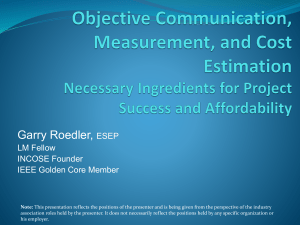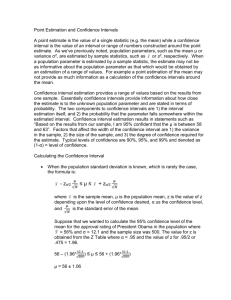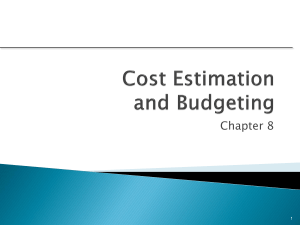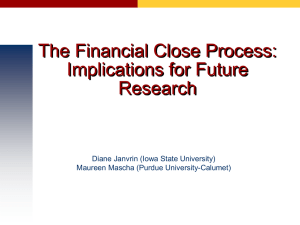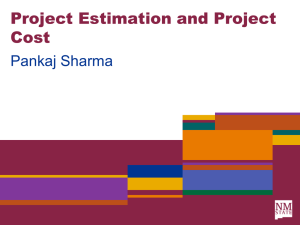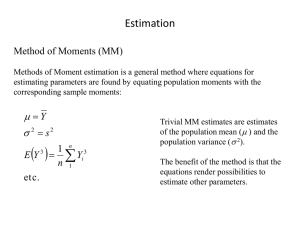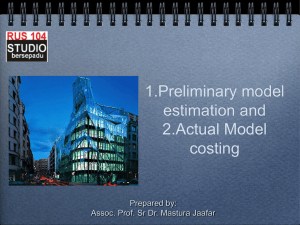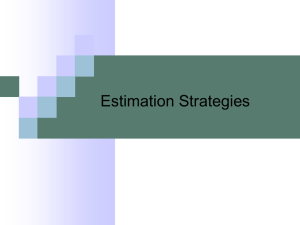Chapter 12: Estimation
advertisement
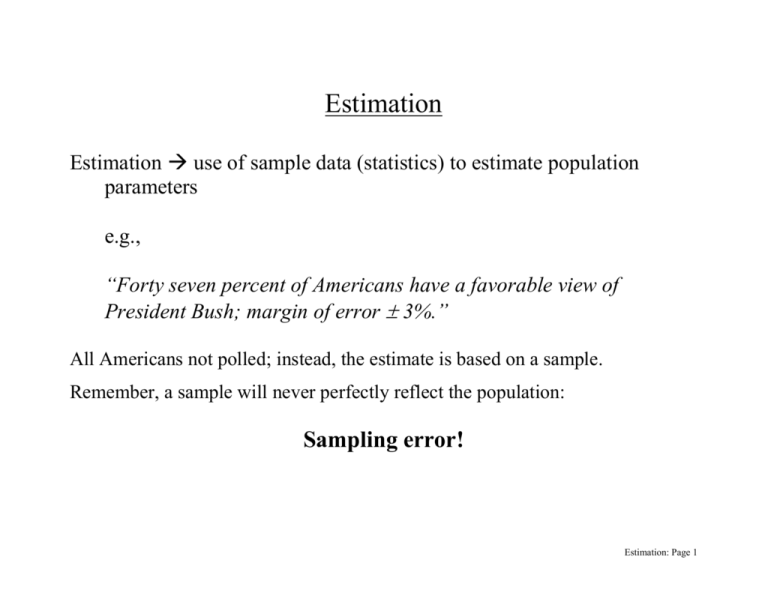
Estimation Estimation use of sample data (statistics) to estimate population parameters e.g., “Forty seven percent of Americans have a favorable view of President Bush; margin of error 3%.” All Americans not polled; instead, the estimate is based on a sample. Remember, a sample will never perfectly reflect the population: Sampling error! Estimation: Page 1 Two types of estimates: (1) Point estimate: single number as the estimate of an unknown quantity e.g., Answering w/ a single value, what was the outdoor temperature in Oxford right before class today? ____ degrees How sure are you of this estimate? (2) Interval estimate / confidence interval (CI): a range of values as the estimate of an unknown quantity; when accompanied w/ a specific confidence level or probability, called confidence intervals e.g., Answering w/ a range of values, what was the outdoor temperature in Oxford right before class today? Between _____ & _____ degrees How sure are you of this estimate? **There is a trade-off between precision & confidence** Estimation: Page 2 Hypothesis Testing vs Estimation Similar Both use sample data to infer something about a population Different Designed to answer different questions Did a new drug lower cholesterol levels? Measure cholesterol of 25 patients before drug & after Change in cholesterol is 15 points (225 before; 210 after) Hypothesis test: Did the drug alter cholesterol levels? yes/no decision Reject or fail to reject H0 Estimation: By how much did the drug alter cholesterol levels? Estimation: Page 3 When is estimation used? 1. After H0 has been rejected A treatment has an effect, but how much? 2. Already know an effect exists, but want to determine size of effect 3. To determine basic information about an unknown population How many pizzas do college students order per month? Take sample as estimate of population average Estimation: Page 4 Sample Statistic Popl’n Parameter X X D D 1 - 2 X1 - X 2 Standard Error x s X sD s X1 X 2 Test Chapter z single-sample t Related-samples t 2 ind. samples t 8 / 12 12 13 14 General form of these test statistics: Sample statistic – unknown (or hypothesized) population parameter z or t = Standard error Will use a slight modification of this general formula to do estimation Estimation: Page 5 Goal: to estimate the value of an unknown parameter Unknown popl’n parameter = b/c we will need an upper & lower bound Sample statistic [(t or z)(standard error)] 1. Sample statistic & standard error calculated from sample data 2. t or z will be selected, based on some criterion 3. For a point estimate, your best estimate of the population parameter is the sample statistic (e.g, X is the best point estimate of ) 4. For an interval estimate, your best estimate is to predict that the sample statistic is in the middle section of the sampling distribution (e.g., the middle 80, 90, 95 or 99%) Estimation: Page 6 Estimation with the z-score: Hypothesis test Population standard deviation known Research questions: (a) Does a special summer reading program help grade-school children? Confidence (b) If so, by how much? Specifically, what will be the mean reading level interval of students who complete the summer program? Point Estimation (c) What will be the mean reading level of students who complete the summer program, with 90% confidence? = 80 = 10 n = 25 X = 88 2nd graders in the school district: Random sample (after summer program): z x = X z x x CI Estimation: Page 7 What is the point estimate? Calculate the confidence interval: (a) Find the standard error: x z X = n x X = 10 2 25 (b) Select the z: For 90%, we want two z-scores the width between which captures the middle 90% of the distribution Thus, we want 5% (.05) in each “tail” See Table E.10: z = 1.65 (c) Use formula: = X z x Upper bound: = 88 + 1.65(2) = 91.3 Lower bound: = 88 - 1.65(2) = 84.7 Estimation: Page 8 Interpretation: “The true population mean reading ability of students after taking the summer program is between 84.7 and 91.30, with 90% confidence.” OR “We are 90% confident that the true population mean of students completing the summer program is between 84.7 and 91.3 on the reading exam.” Note: Our sample mean is exactly in the middle of the interval: Lower Bound 84.7 Difference of 3.3 88.0 Sample Mean 91.3 Upper Bound Difference of 3.3 Estimation: Page 9 Estimation with the t statistic: 1. Single-sample t (similar to z, but population standard deviation unknown) CI = X t sx 2. Related-samples t CI D= D t sD 3. Independent-samples t 1 - 2 = (X1 X 2 ) t sx 1 x2 CI Estimation: Page 10 Estimation with the single-sample t statistic: Market research firm is interested in determining the mean age of customers who buy its products with 95% confidence Sample: n = 30 X = 30.5 s2 = 24.45 What is the point estimate? Calculate the confidence interval: (a) Find the estimated standard error: sX = s2 24.45 .90 n 30 Estimation: Page 11 (b) Select the t: For 95% confidence, we want two t-scores the width between which captures the middle 95% of the distribution But remember, there is a different t distribution for every df Must find df (n – 1) first df = 30 – 1 = 29 We want a TOTAL of 5% (.05) in the two tails See Table E.6: t (29) = 2.045 (c) Use formula: = X t s x Upper bound: = 30.5 + 2.045(0.9) = 32.34 Lower bound: = 30.5 – 2.045(0.9) = 28.66 Interpretation: “The true population mean age of the customers is between 28.66 and 32.34 years, with 95% confidence.” Estimation: Page 12 Estimation with the related-samples t statistic: A clinical psychologist has determined that a new form of behavioral therapy decreases depression. She is now interested to determine the size of this decrease, with 99% confidence. Random sample of 25 depressed patients: depression levels measured before and after therapy Difference between scores is obtained for each patient, and the average decrease in depression scores across patients was D = 13.2, with sD2 = 39.58 (a) Find the standard error: sD = sD 2 39.58 1.26 n 25 Estimation: Page 13 (b) Select the t: For 99% confidence, we want two t-scores the width between which captures the middle 99% of the distribution But remember, there is a different t distribution for every df Must find df (n – 1) first df = 25 – 1 = 24 We want a TOTAL of 1% (.01) in the two tails See Table E.6: t (24) = 2.797 (c) Use formula: D= D t sD Upper bound: D = 13.2 + 2.797(1.26) = 16.72 Lower bound: D = 13.2 – 2.797(1.26) = 9.68 Interpretation: “With 99% confidence, the true population decrease in depression following the behavioral therapy is between 9.68 and 16.72.” Estimation: Page 14 Estimation with the two independent-samples t statistic: People often “loaf” when in a group Determine the magnitude of this “loafing” effect, w/ 90% confidence Had one group of Ps work on a project alone Had a second group of Ps work on a project in a group Measured amount of time the participant worked Alone n = 15 X = 20 min s2 = 14.29 Group n = 10 X = 11 min s2 = 12.22 1 - 2 = ( X1 X 2 ) t sx 1 x2 (a) Find difference between samples: X1 - X 2 = 20 – 11 = 9 This is our point estimate Estimation: Page 15 (b) Find the standard error: 1. Pool the two variances: s 2p (n1 1)s12 (n2 1)s22 14(14.29) 9(12.22) 13.48 (n1 n2 2) 23 2. Use pooled variance to find standard error s X1 X 2 = s 2p s 2p 13.48 13.48 0.8991.348 1.50 n1 n2 15 10 Estimation: Page 16 (c) Select the t: For 90% confidence, we want two t-scores the width between which captures the middle 90% of the distribution But remember, there is a different t distribution for every df Must find df first: df = df1 + df2 or (n1 – 1) + (n2 – 1) df = (15 – 1) + (10 – 1) = 14 + 9 = 23 We want a TOTAL of 10% (.10) in the two tails See Table E.6: t (23) = 1.714 (d) Use formula: 1 - 2 = ( X1 X 2 ) t sx 1 x2 Upper bound: 1 - 2 = 9 + 1.714(1.5) = 11.57 Lower bound: 1 - 2 = 9 – 1.714(1.5) = 6.43 Interpretation: “The presence of others causes people to work less (to loaf). With 90% confidence, the true population average decrease in work time is between 11.57 and 6.43 minutes.” Estimation: Page 17 Final Notes: (1) Trade-off between precision & confidence More confidence larger interval Less confidence smaller interval With 99% confidence. . . Upper bound: D = 13.2 + 2.797(1.26) = 16.72 Lower bound: D = 13.2 – 2.797(1.26) = 9.68 With 90% confidence. . . Upper bound: D = 13.2 + 1.711(1.26) = 15.36 Lower bound: D = 13.2 – 1.711(1.26) = 11.04 Spread of 7.04 Spread of 4.32 (2) Sample size influences confidence intervals Larger samples smaller standard error smaller intervals Smaller samples larger standard error larger intervals Estimation: Page 18
